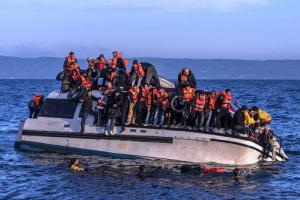Refugee crisisTerrorists may have entered Europe hiding among asylum-seekers: EU border police
Frontex, the EU’s border police, has said that terrorists may have entered Europe by hiding among asylum seekers. Frontex noted that two of the bombers in last November’s Paris attacks made it to the continent in a smuggling boat from Turkey. “As the vast majority of migrants arrive undocumented, screening activities are essential to properly verify their declaration of nationality,” the report says.

Refugees arriving at Greece // Source: commons.wikimedia.org
Frontex, the EU’s border police, has said that terrorists may have entered Europe by hiding among asylum seekers. Frontex noted that two of the bombers in last November’s Paris attacks made it to the continent in a smuggling boat from Turkey.
Frontex’s Risk Analysis for 2016, released on Tuesday, said: “The Paris attacks in November 2015 clearly demonstrated that irregular migratory flows could be used by terrorists to enter the EU.”
Echoing observations made five months ago, the report added: “Two of the terrorists involved in the attacks had previously irregularly entered through Leros and had been registered by the Greek authorities. They presented fraudulent Syrian documents to speed up their registration process.
“As the vast majority of migrants arrive undocumented, screening activities are essential to properly verify their declaration of nationality.”
Most of the report deals with the broader issue of refugees and asylum-seekers arriving in Europe.
Last year, an estimated one million migrants arrived in Europe, accounting for the record number of 1.82 million detections of illegal border crossings reported by EU member states. The number of detections was more than six times the previous record set in 2014.
A large number of illegal crossings were made by people who were counted for the first time when arriving on the Greek islands from Turkey and later were counted again when crossing one of EU’s external borders in the Western Balkans.
In its report, Frontex says that the Eastern Mediterranean route, especially the Greek islands in the Aegean, accounted for the largest number of detections — nearly 885,400. More than 90 percent of the detections, or 803,000, were reported in the second half of the year. Syrian nationals accounted for the largest proportion of arrivals, although the share of Afghans rose significantly towards the end of the year. Iraqis were the third largest nationality using this route.
Some 764,000 detections were recorded on the Western Balkan route, mainly on Hungary’s and Croatia’s border with Serbia.
In 2015, the number of migrants arriving via the Central Mediterranean route fell by about a tenth to 154,000, in large part due to the fact that Syrians had switched to using the Eastern Mediterranean route. However, the number of East and West Africans steadily increased by 42 percent to more than 108,000. The most often reported nationality was Eritrean, although by regions, the majority of the migrants came from West Africa.
The share of rubber boats used on this route increased last year. The use of weak, overcrowded boats with limited fuel supplies by smugglers seeking to maximize their profits put migrant lives at risk, leading to search and rescue operations saving an unprecedented number of people. Frontex says it saved some 40 percent of the people rescued in the Central Mediterranean region and 90 percent of those near the Greek islands in the Aegean.
The record number of migrants seeking to make their way to Europe also led to an increase in the number of detections of people smugglers, which rose by a fifth to more than 12,000. Moroccans, Spaniards, Albanians and Syrians were the most represented nationalities among the people smugglers. On several occasions, especially on the Central Mediterranean route, smugglers threatened border guards and rescue teams to recover the boats used to transport migrants.
The number of asylum applications in 2015 rose to an unprecedented level of 1.35 million, according to EASO. However, the number of return decisions issued by the Member States (286,700) and the number of effective returns (175,200) remained relatively stable when compared to the previous year. Albanians accounted for 17 percent of all effective returns, trailed by Ukrainians (8.6 percent) and residents of Kosovo (5.8 percent) (this designation is without prejudice to positions on status, and is in line with UNSCR 1244 and the ICJ Opinion on the Kosovo declaration of independence).
The Annual Risk Analysis for 2016 also describes a series of alternative futures developed in collaboration with experts from relevant stakeholder organizations. These scenarios may be used as a foresight instrument at a strategic level.
The Annual Risk Analysis also points out three major challenges to be faced at the external borders: an unprecedented rise in migratory pressure, an increasing terrorist threat and a steady rise in the number of regular travelers.
— Read more in Risk Analysis for 2016 (Frontex, 2016)
